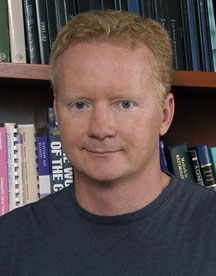

Scientists Engineer New Type of Vaccination that Provides Instant Immunity
By Anna Sobkowski
A team of scientists at the Scripps Research Institute has found a way to use specially programmed chemicals to elicit an immediate immune response in laboratory animals against two types of cancer. The experiments, thus far performed only in mice, appear to overcome a major drawback of vaccinations—the lag time of days, or even weeks, that it normally takes for immunity to build against a pathogen. This new method of vaccination could potentially be used to provide instantaneous protection against diseases caused by viruses and bacteria, cancers, and even virulent toxins.
The work is being published in the Early Edition of the Proceedings of the National Academy of Sciences (PNAS) the week of March 2, 2009.
The team, led by Scripps Professor Carlos Barbas, III tested the vaccination method—called covalent immunization—on mice with either melanoma or colon cancer.
The scientists injected these mice with chemicals specifically designed to trigger a programmable and "universal" immune reaction. They developed other chemicals, "adapter" molecules," that recognized the specific cancer cells. Once injected into the animal, the adapter molecules self-assembled with the antibodies to create covalent antibody-adapter complexes.
"The antibodies in our vaccine are designed to circulate inertly until they receive instructions from tailor-made small molecules to become active against a specific target," Barbas says. "The advantage of this method is that it opens up the possibility of having antibodies primed and ready to go in the time it takes to receive an injection or swallow a pill. This would apply whether the target is a cancer cell, flu virus, or a toxin like anthrax that soldiers or even civilian populations might have to face during a bioterrorism attack."
Only those mice that received both the vaccine and the adapter compound generated an immediate immune attack on the cancer cells that led to significant inhibition of tumor growth. This is the first time that such a covalent vaccine has been successfully designed and tested—typically, antibodies do not bind to chemicals in this covalent fashion.
The current breakthrough builds on work the Barbas and Sinha laboratories have been engaged in for the past few years on chemically programmed monoclonal antibodies, a new class of therapeutics that the group invented. In this type of therapy, small, cell-targeting molecules and non-targeting catalytic monoclonal antibodies self-assemble to target pathogens. Monoclonal antibodies are produced in the laboratory from a single cloned B-cell—the immune system cell that makes antibodies—to bind to a specific substance. Three clinical trials are now under way by Pfizer to test the therapeutic effectiveness of this new type of therapy in cancer and diabetes. The antibodies in the antibody-adapter complex are monoclonal antibodies engineered to link themselves to adapter molecules.
The Search for the Ideal Vaccination
The practice of vaccination has been extraordinarily successful in controlling certain diseases, but there are drawbacks. Vaccine development can be an educated guessing game—in the case of the flu, for example, scientists must study worldwide outbreak patterns to anticipate which type of flu might strike a particular area. In addition, the most common vaccination strategies use whole proteins, viruses, or other complex immunogens—not just the specific part of the macromolecule that is recognized by the immune system—to elicit an immune response, which makes for wasted immune activity. Then there is the body's own kinetics—the time it takes to mount a disease-relevant immune response to immunogens limits the speed with which immunity can be achieved. Finally, age-related declines in the ability to mount strong immune responses to biological-based vaccines present another challenge to the effectiveness of such vaccines.
Barbas's chemical-based—rather than biological based—approach to vaccine development addresses many of these challenges.
"Our approach differs from the traditional vaccine approach in the sense that when we design an antibody-adapter compound we know exactly what that compound will react with," Barbas says. "The importance of this is best exemplified with HIV. In current vaccines, many antibodies are generated against HIV, but most are not able to target the active part of the virus."
In the near term, Barbas will apply his covalent vaccination approach to HIV, cancer, and infectious diseases for which no vaccines currently exist. A particular focus will be creating adapter molecules specific to these diseases.
"We believe that chemistry-based vaccine approaches have been underexplored and may provide opportunities to make inroads into intractable areas of vaccinology," Barbas says.
In addition to Barbas, co-authors of the paper, "Instant immunity through chemically programmable vaccination and covalent self-assembly," are Mikhail Popkov (who is first author), Beatriz Gonzalez, and Subhash C. Sinha, all of The Scripps Research Institute. See http://www.pnas.org/content/early/2009/02/27/0900147106.abstract.
The study was funded by the Skaggs Institute for Chemical Biology and the National Institutes of Health.
Send comments to: mikaono[at]scripps.edu

"We believe that chemistry-based vaccine approaches have been
underexplored and may provide opportunities to make inroads into intractable
areas of vaccinology," says Professor Carlos Barbas.
